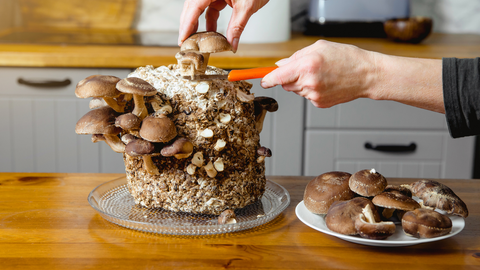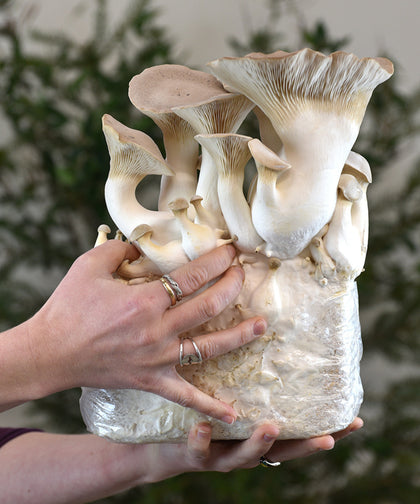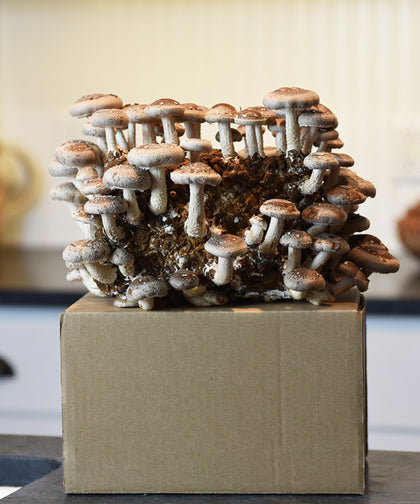Growing mushrooms at home is an intriguing and rewarding endeavour that can yield delicious and nutritious results. This comprehensive guide aims to walk you through the process from start to finish, covering the basics of getting started, choosing the right mushrooms, preparing and inoculating the growing medium, incubating and fruiting your mushrooms, and finally, harvesting and storing your bounty. We'll also touch upon troubleshooting common problems to ensure your mushroom cultivation is a success.
Introduction
Why Grow Mushrooms at Home?
Growing mushrooms at home offers a range of benefits. Not only does it provide a fresh, organic source of delicious mushrooms, but it's also an engaging way to understand more about these fascinating organisms. Mushroom cultivation can be a hobby that doesn't require extensive space or a significant investment, making it accessible to many.
Benefits of Growing Your Own Mushrooms
Home-grown mushrooms ensure you're eating a product free of pesticides and chemicals. It's also cost-effective in the long run and can be a sustainable practice, as many mushrooms grow on substrates that are by-products of other agricultural processes or household waste, such as coffee grounds.
The Stuff You Need to Get Started
To begin, you'll need basic supplies like mushroom spores or spawn, a growing medium, containers or bags for incubation, and a sterile environment for inoculation. The specifics will depend on the type of mushroom you choose to grow.
Mushroom Growing Techniques
Urban Leaf's focus is on growing food in urban spaces, and so this blog will only cover the techniques that are accessible to those of us who live in apartments.
Bucket Method - with Coffee Grounds and Kitchen Scraps
Utilizing coffee grounds and kitchen scraps as a substrate is an excellent way for apartment dwellers to recycle waste into a valuable resource for growing mushrooms. Oyster mushrooms, in particular, thrive on coffee grounds due to their high nitrogen content. This method requires minimal space, such as a small container on a kitchen counter or shelf and typically involves growing mushrooms in a large bucket.
Mushroom Grow Kits
Mushroom grow kits are perfect for beginners and those with limited space. These kits come with everything needed to start growing mushrooms, including the spores and substrate. They are designed to be compact and require only a small area with indirect light. Urban Leaf offers a variety of mushroom grow kits suitable for apartment living, making it easy to get started.
Monotub Method
The monotub method involves growing mushrooms in a single, sealable container, like a large plastic tote. This method is slightly more advanced but can be adapted to small spaces. By controlling humidity, temperature, and light within the tub, apartment dwellers can efficiently produce a substantial yield of mushrooms.
Best Types of Mushrooms To Grow At Home
Certain varieties of mushrooms are more suited to indoor cultivation due to their growing requirements and resilience. Here's a list of the most suitable mushroom varieties for apartment dwellers, along with some notes on their growing conditions:
- Oyster Mushrooms (Pleurotus ostreatus): Oyster mushrooms are one of the easiest varieties to grow indoors. They thrive on a wide range of substrates, including coffee grounds, straw, and sawdust. These mushrooms prefer high humidity and indirect light. Their fast growth rate and high yield make them an excellent choice for beginners.
- Shiitake Mushrooms (Lentinula edodes): Shiitake mushrooms require a bit more patience but are well worth the effort. They are typically grown on hardwood logs or sawdust blocks. Indoor growers can use shiitake grow kits that simplify the process. Shiitakes need a cool, dark place to incubate and a more humid, brighter environment to fruit.
- Lion's Mane (Hericium erinaceus): Known for its unique appearance and health benefits, Lion's Mane can be grown on hardwood sawdust or logs. It requires a humid environment and moderate temperatures to thrive. This variety is particularly fascinating to watch grow and yields a distinctive, flavorful mushroom.
- White Button Mushrooms (Agaricus bisporus): White button mushrooms are the most commonly consumed variety and can be grown in containers using compost as the substrate. They prefer cooler temperatures, around 55-60°F (13-16°C) for the incubation phase, and slightly warmer temperatures for fruiting. Regular misting is necessary to maintain the high humidity levels they love.
- Enoki Mushrooms (Flammulina velutipes): Enoki mushrooms are known for their long, slender stems and small caps. They require a cooler temperature range, similar to button mushrooms, and high humidity. Enokis grow best on a substrate of hardwood sawdust and benefit from being kept in the dark during their initial growth phase.
- Portobello Mushrooms (Agaricus bisporus): Portobellos are simply mature white button mushrooms and can be grown under the same conditions. They need a nutrient-rich compost substrate and consistent moisture. The key difference is allowing the mushrooms to mature fully to reach the large size that Portobellos are known for.
- Reishi Mushrooms (Ganoderma lucidum): Reishi, a medicinal mushroom, prefers hardwood substrates, like sawdust or logs. They require a warm and humid environment to start but need less humidity as they mature. Reishi mushrooms are more challenging to grow but rewarding for their medicinal properties.
Steps For Growing Mushrooms At Home
Growing Medium / Substrate Preparation
The first step is to prepare the substrate that the mushrooms will be growing in.
- Bucket Method: If you’re using the bucket method, then you just want to collect the coffee grounds and/or other kitchen scraps in a large bucket, mix them well, and ensure they are moist but not waterlogged.
- Monotub Method: The monotub method typically uses a more controlled substrate, often consisting of sterilized grains (like rye berries) mixed with a bulk substrate (such as coco coir and vermiculite). The preparation involves soaking and sterilizing the grains to eliminate contaminants, then mixing them with the pasteurized bulk substrate in a large, sealable plastic tote.
- Kit Method: not applicable - the kit supplier does this for you.
Inoculating
- Bucket Method: Inoculation involves adding mushroom spawn directly to the cooled mixture of coffee grounds and kitchen scraps. It's important to mix thoroughly to distribute the spawn evenly. This method may require a slightly higher spawn rate due to the potential for contamination in the non-sterile substrate.
- Monotub Method: After preparing the substrate in the monotub, inoculate by evenly distributing the spawn throughout the substrate. Because the substrate and grains have been pasteurized or sterilized, the risk of contamination is lower, allowing for a lower spawn rate compared to the bucket method.
- Kit Method: not applicable - the kit supplier does this for you.
Incubating
This phase involves keeping the inoculated substrate in a dark, warm place to allow the mycelium to colonize the substrate fully. This process can take several weeks, depending on the mushroom species and environmental conditions. The ideal temperature for incubation usually ranges from 75-80°F (24-27°C).
If you’re buying a kit, then this will have been completed before it ships to you.
Fruiting
The fruiting phase is the first one that all three methods have in common.
What we’re wanting to achieve here is:
- An increase in the amount of light - typically either from indirect sunlight or a fluorescent,
- Lowering the temperature a little,
- Increasing air exchange and
- Increasing humidity
The monotub method allows the most precise control here because you’re growing within a small ‘controlled’ environment. You’re likely to have far less control when using the other methods. For this reason, you should expect that the results will differ at different times of the year. Most homes will experience some variance in temperature and humidity through the year.
Harvesting
The harvesting process is similar for all methods once the mushrooms are ready. Mushrooms should be harvested just before or as the veil beneath the mushroom caps begins to tear. This timing ensures the best texture and flavor. To harvest, gently twist and pull the mushrooms from the substrate. Avoid pulling too hard to prevent damaging the mycelium, which may yield additional flushes of mushrooms.
Start Your Mushroom Journey Today
Ready to get started? Head on over to our mushroom section and start exploring all the ready-to-go kits and you could be enjoying your own home-grown mushrooms in just a few weeks!







